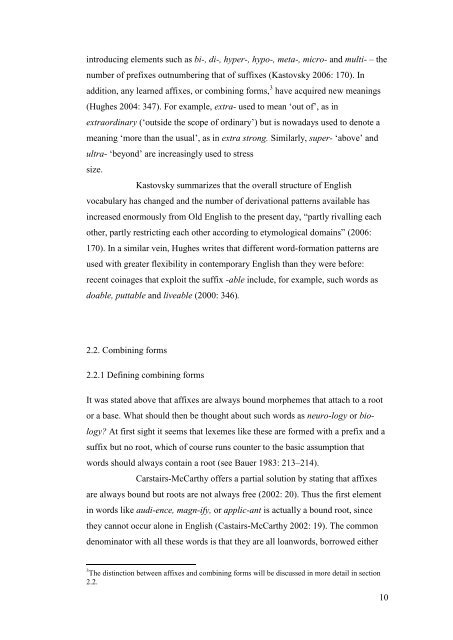The morphological productivity of selected ... - Helda - Helsinki.fi
The morphological productivity of selected ... - Helda - Helsinki.fi
The morphological productivity of selected ... - Helda - Helsinki.fi
You also want an ePaper? Increase the reach of your titles
YUMPU automatically turns print PDFs into web optimized ePapers that Google loves.
introducing elements such as bi-, di-, hyper-, hypo-, meta-, micro- and multi- – the<br />
number <strong>of</strong> pre<strong>fi</strong>xes outnumbering that <strong>of</strong> suf<strong>fi</strong>xes (Kastovsky 2006: 170). In<br />
addition, any learned af<strong>fi</strong>xes, or combining forms, 3 have acquired new meanings<br />
(Hughes 2004: 347). For example, extra- used to mean ‘out <strong>of</strong>’, as in<br />
extraordinary (‘outside the scope <strong>of</strong> ordinary’) but is nowadays used to denote a<br />
meaning ‘more than the usual’, as in extra strong. Similarly, super- ‘above’ and<br />
ultra- ‘beyond’ are increasingly used to stress<br />
size.<br />
Kastovsky summarizes that the overall structure <strong>of</strong> English<br />
vocabulary has changed and the number <strong>of</strong> derivational patterns available has<br />
increased enormously from Old English to the present day, “partly rivalling each<br />
other, partly restricting each other according to etymological domains” (2006:<br />
170). In a similar vein, Hughes writes that different word-formation patterns are<br />
used with greater flexibility in contemporary English than they were before:<br />
recent coinages that exploit the suf<strong>fi</strong>x -able include, for example, such words as<br />
doable, puttable and liveable (2000: 346).<br />
2.2. Combining forms<br />
2.2.1 De<strong>fi</strong>ning combining forms<br />
It was stated above that af<strong>fi</strong>xes are always bound morphemes that attach to a root<br />
or a base. What should then be thought about such words as neuro-logy or biology?<br />
At <strong>fi</strong>rst sight it seems that lexemes like these are formed with a pre<strong>fi</strong>x and a<br />
suf<strong>fi</strong>x but no root, which <strong>of</strong> course runs counter to the basic assumption that<br />
words should always contain a root (see Bauer 1983: 213–214).<br />
Carstairs-McCarthy <strong>of</strong>fers a partial solution by stating that af<strong>fi</strong>xes<br />
are always bound but roots are not always free (2002: 20). Thus the <strong>fi</strong>rst element<br />
in words like audi-ence, magn-ify, or applic-ant is actually a bound root, since<br />
they cannot occur alone in English (Castairs-McCarthy 2002: 19). <strong>The</strong> common<br />
denominator with all these words is that they are all loanwords, borrowed either<br />
3 <strong>The</strong> distinction between af<strong>fi</strong>xes and combining forms will be discussed in more detail in section<br />
2.2.<br />
10
















